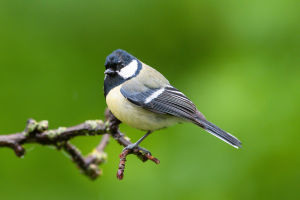The Great Tit (Parus major)
The Great Tit (Parus major) is a charismatic and colorful songbird that is easily recognized by birdwatchers across Europe and parts of Asia.
Known for its bold personality, distinctive appearance, and melodious calls, the Great Tit has a fascinating natural history that makes it a favorite among bird lovers.
Appearance and Identification
With its vibrant yellow underparts, striking black head, and a bold white cheek patch, the Great Tit stands out in the bird world. The bird’s blue-gray wings and olive-green back add to its colorful appearance. Males tend to have a more vivid color contrast, and a broader black stripe running down their belly, while females have a slightly duller tone.
The Great Tit’s average size is about 14 cm (5.5 inches), making it one of the larger tit species. Its robust bill is perfectly suited for cracking open seeds, and its strong legs help it forage both on trees and the ground.
Habitat and Distribution
The Great Tit is incredibly adaptable and can be found in a variety of habitats, including woodlands, gardens, parks, and even urban areas. They prefer deciduous or mixed forests, especially those with plenty of trees that provide nesting holes. However, they are not fussy and will easily nest in artificial nest boxes or other cavities.
Their distribution spans across Europe, North Africa, and much of Asia, and they are non-migratory, meaning they tend to stay in their territory year-round.
Feeding Behavior
Great Tits are omnivorous, with a diet that changes depending on the season. In summer, they primarily feed on insects, which are abundant and provide the protein needed for breeding and rearing young. Caterpillars are a particular favorite during this time. In autumn and winter, their diet shifts more towards seeds, berries, and nuts.
They are frequent visitors to bird feeders, where they enjoy sunflower seeds, peanuts, and suet. Their foraging behavior is bold and dynamic, often seen hopping from branch to branch, pecking at bark to extract insects or seeds.
Vocal Abilities
One of the most delightful aspects of the Great Tit is its diverse vocal range. With over 40 different calls and songs, it uses its voice to communicate with other birds, defend territory, and attract mates. Their songs are often a loud and clear "tee-cha tee-cha" sound, but they can also mimic the calls of other birds, adding to their charm and intelligence.
Their adaptability in vocalizations makes them a key species for scientific studies on bird communication and learning.
Reproduction and Nesting
During the breeding season, typically between March and July, Great Tits build their nests in tree cavities or artificial nest boxes. The female constructs the nest using moss, feathers, and fur, creating a cozy environment for her eggs. A typical clutch consists of 6 to 12 eggs, which are white with reddish-brown speckles.
Both parents take turns feeding the chicks once they hatch, and after about 18 to 21 days, the young birds are ready to fledge. Parental care continues even after the young leave the nest, with the parents teaching them how to forage and avoid predators.
Adaptation to Urban Environments
The Great Tit’s ability to adapt to human presence has made it one of the most common garden birds in Europe. They readily take to nest boxes provided by humans and benefit from backyard bird feeders during the colder months when food is scarce. Their boldness and intelligence allow them to thrive even in heavily populated urban areas.
How does a Great Tit bathe? | Parus major | Cute Birds | Birdbath
Video by Soothing Nature & Funny SurpriseToys
The Great Tit is not just another pretty bird. Its bold personality, adaptability, and intelligence make it a remarkable species that has successfully integrated into both natural forests and urban landscapes. Whether you're a seasoned birdwatcher or just someone who enjoys the songs of the garden, the Great Tit is sure to leave a lasting impression with its vivid colors and lively calls.


